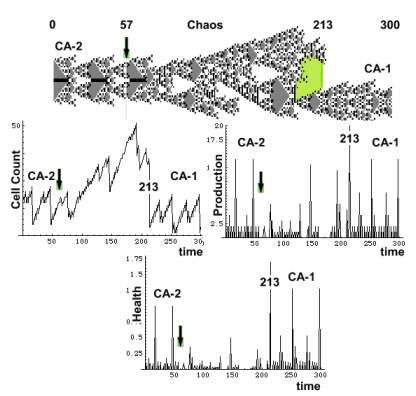 |
Optimality
The previous experiment demonstrated the
four types of response by an injured
stationary process (CA) :
1. No change,
2. A new
stationary oscillating attractor
3. Chaotic
oscillations
4. Death
An isolated (non-interacting) process
(CA) oscillates around a fixed attractor. This state is called in medicine
Homeostasis (steady state). If injury does not force it from its current
attractor, the CA is immune to it. Otherwise it responds with a chaotic
oscillation, which may either establish a new oscillating attractor, or
the CA dies. A CA does not proceed directly from
one stationary attractor to another. It always traverses first through a chaotic state.
The
following experiment describes such a transition in detail It started in the chapter Perturbation of a
Non-linear Process, when a zygote was planted and grew into a 'parent
CA-1' with a period of 46 days.
Next, the parent CA-1 was injured, and after a brief transition became
an 'offspring CA-2' with a period of 29 days.
In the present experiment offspring CA-2 was injured and resumed
its parent phenotype (v. Memory of a Nonlinear Process)
The
experiment starts at time = 0. CA-2 (offspring) oscillates with a period
of 29 days. On day 57 it is injured, whereupon it enters a chaotic state
which ends on day 213 when the parent CA-1 emerges (period 46).
 |
The left graph depicts cell count changes. Following injury the count rises, and on day 213 it declines abruptly. The green mask covers the white area which still belongs to the chaotic CA. When cell count reaches its peak, one of the cells becomes a zygote (blastema). As other CA-2 cells gradually disappear zygote generates a parent CA-1.
During
the chaotic phase CA production declines. On day 213 when CA-2 cells die,
production rises sharply, and then declines to the CA-1 level. Throughout the chaotic phase CA-2 is less
healthy. Upon its transformation into CA-1 it health improves.
The
CA repertory consists of three states, two stable attractors ,parent and
offspring, and a chaotic transition.
When perturbed, the
CA enters a chaotic phase during which it
attempts to settle down at a stable attractor, which happens when a chaotic structure matches one of the
structures in the oscillating CA. The parent has 46 such structures, and
when the chaotic CA takes on one of them, it enters the parent attractor.
This may require time. In
this short experiment, the chances that
such an event will happen, are slim.
The CA applies its rescue repertory, and generates a blastema.
The
transition from the chaotic phase to a stable attractor is called a
solution. When perturbed, the CA seeks
a solution, otherwise it may die. On one hand perturbation is dangerous,
since it drives the CA through an inefficient chaotic phase, when its
health declines. On the other
hand, it forces the CA to seek new solutions which may improve its condition.
In the present experiment injury drove CA-2 to the healthier state of
CA-1. (v. Immunity)
Optimality principle
Similar transitions and responses occur also in our body.
When perturbed, WOB always finds the optimal or healthiest solution under
the circumstances. This ought
to be regarded as a principle
that marks life and operates in all life forms. It keeps us alive!
We may now rephrase the four causes of change as follows:
1. Material cause:
CA structure, and age
2. Formal
cause: Its rule
3. Efficient
cause: Perturbation (injury)
4. Final
cause: Optimality
Teleology
Final cause explaines change by the purpose it may have. It is known also as teleology. This kind of explanation is rejected by Physics, since the mechanistic world-view considers only the efficient cause and has little room for purposefulness. Yet the final cause is essential when explaining the change of life forms, in which the purpose of change is to optimize Suppose a well defined physical force propels an animal. Its center of mass traces a trajectory of a shotgun and obeys Newton's laws of motion. However in the context of its body, perturbation affects myriad processes, which adjust optimally to the new situation. Unlike the projectile, which follows a four-dimensional path, the animal traces a multi dimensional trajectory. In the first four dimensions (space and time) its change is determined by the efficient cause (laws of mechanics). while its higher dimensions are controlled by optimality, or final cause.
Setup
effect[1,500];
effect[2, 500]; injurystate[1, j, 47, f[[1,1]], 1, 0]; restoreparams[1,1,1];
restoreparams[2,2,1]; injurystate[1, j, 57, f[[1,1]], 1, 0];